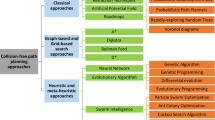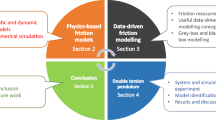Abstract
Force control for robot manipulators is increasingly demanded for stable and desired interaction between robots and environments. In this paper, several modifications of an admittance force control scheme are presented and derived from force tracking impedance functions to give a force tracking capability to position-controlled robot manipulators. Admittance force control known as the position-based force control has a structural advantage of easy implementation for the force control capability to the existing position-controlled robot systems by closing an outer force control loop. The admittance filter as an inverse of impedance function is implemented to filter force errors to modify the reference position such that the eventual force tracking impedance control is realized indirectly. Admittance filters are formulated from impedance functions that guarantee the desired force/position tracking performances with the help of the time-delayed controller. Desired contact force/position tracking control is achieved under uncertain environment and dynamics. Extensive simulation studies of force/position tracking control performances of the proposed control schemes for a robot manipulator are conducted to confirm the proposition.
Similar content being viewed by others
References
W. Li, Y. Han, J. Wu, and Z. Xiong, “Collision detection of robots based on a force/torque sensor at the bedplate,” IEEE/ASME Trans. on Mechatronics, vol. 25, no. 5, pp. 2565–2573, 2020.
Y. Lou, J. Wei, and S. Song, “Design and optimization of a joint torque sensor for robot collision detection,” IEEE Sensor Journal, vol. 19, no. 16, pp. 6618–6627, 2019.
Y. J. Heo, D. Y. Kim, W. Lee, H. K. Kim, J. H. Park, and W. K. Chung, “Collision detection for industrial collaborative robots: A deep learning approach,” IEEE Robots and Automation Letters, vol. 4, no. 2, pp. 740–746, 2019.
K. M. Park, J. H. Kim, J. H. Park, and F. C. Park, “Learning-based real-time detection of robot collisions without joint torque sensors,” IEEE Robots and Automation Letters, vol. 6, no. 1, pp. 103–110, 2019.
M. Raibert and J. J. Craig, “Hybrid position/force control of manipulators,” ASME Journal. of Dynamic Systems, Measurements, and Control, vol. 102, pp. 126–133, 1981.
N. Hogan, “Impedance control: An approach to manipulator, Part i, ii, iii,” ASME Journal of Dynamics Systems, Measurements, and Control, vol. 3, pp. 1–24, 1985.
R. J. Anderson and M. W. Spong, “Hybrid impedance control of robot manipulators,” IEEE Journal of Robotics and Automation, vol. 4, no. 5, pp. 549–556, 1988.
S. Jung, T. C. Hsia, and R. G. Bonitz, “Force tracking impedance control for robot manipulators with an unknown environment: Theory, simulation, and experiment,” The International Journal of Robotics Research, vol. 20, no. 9, pp. 765–774, 2001.
S. Jung, T. C. Hsia, and R. G. Bonitz, “Force tracking impedance control of robot manipulators under unknown environment,” IEEE Trans. on Control Systems Technology, vol. 12, no. 3, pp. 474–483, 2004.
S. Jung, “A position-based force control approach to a quad-rotor system,” URAI, pp. 373–377, 2012.
H. Seraji, “Adaptive admittance control: An approach to explicit force control in compliant motion,” Proc. IEEE Conference on Robotics and Automations, pp. 2705–2712, 1994.
Q. Yang, J. Niu, and R. Song, “Admittance control of a 3 DOF cable-driven rehabilitation robot for upper-limb in three dimensional workspace,” ICARM, pp. 445–449, 2017.
E. E. Cruz and W. Y. Liu, “Stable PD position/force control in bidirectional teleoperation,” Proc. of International Conference on Electrical Engineering, Computing Science and Automatic Control, 2018.
Z. Li, B. Huang, Z. Ye, M. Deng, and C. Yang, “Physical human-robot interaction of a robotic exoskeleton by admittance control,” IEEE Trans. on Industrial Electronics, vol. 65, no. 12, pp. 9614–9624, 2018.
G. Kang, H. S. Oh, J. K. Seo, U. Kim, and H. R. Choi, “Variable admittance control of robot manipulators based on human intention,” IEEE/ASME Trans. on Mechatronics, vol. 24, no. 3, pp. 1023–1032, 2019.
S. Jung, “Admittance force tracking control for positioncontrolled robot manipulators under unknown environment,” ICCAS, pp. 219–224, 2020.
T. C. Hsia, “On a simplified joint controller design for robot manipulators,” Proc. of IEEE Conf. on CDC, pp. 1024–1025, 1987.
K. Yousef-Toumi and O. Ito, “A time-delay controller for systems with unknown dynamics,” Journal of Dynamic Systems, Measurement, and Control, vol. 112, pp. 133–142, 1990.
P. H. Chang and S. H. Park, “On improving time-delay control under certain hard nonlinearities,” Mechatronics, vol. 13, pp. 393–412, May 2003.
S. U. Lee and P. H. Chang, “The development of antiwindup scheme for time delay control with switching action using integral sliding surface,” Trans. ASME J. Dyn. Syst. Meas. Control, vol. 125, no. 4, pp. 630–638, Dec. 2003.
S. Jung, “Stability analysis of reference compensation technique for controlling robot manipulators by neural network,” International Journal of Control, Automation, and Systems, vol. 15, no. 2, pp. 952–958, 2017.
S. Jung, “Improvement of tracking control of a sliding mode controller for robot manipulators by a neural network,” International Journal of Control, Automation, and Systems, vol. 16, no. 2, pp. 937–943, 2018.
Y. G. Bae and S. Jung, “Balancing control of a mobile manipulator with two-wheels by an acceleration-based disturbance observer,” International Journal of Humanoid Robotics, vol. 15, no. 3, 2018.
Author information
Authors and Affiliations
Corresponding author
Additional information
Recommended by Editor Fumitoshi Matsuno. This paper was supported by the National Research Foundation of Korea under the grant (2017K1A3A1A68072072 & 2019R1I1A3A01062567) and Korea Institute for Advancement of Technology (P0008473, HRD Program for Industrial Innovation).
Seul Jung received his B.S. degree in electrical and computer engineering from Wayne State University, Detroit, MI, USA in 1988, and his M.S. and Ph.D. degrees in electrical and computer engineering from the University of California, Davis in 1991 and 1996, respectively. In 1997, he joined the Department of Mechatronics Engineering, Chungnam National University, where he is presently a professor. His research interests include intelligent mechatronics systems, intelligent robotic systems, autonomous navigation, gyroscope applications, and robot education.
Do-Jin Jeong received his B.S. degree in mechanical engineering from Han Nam University in 2019. He is currently a graduate student for a master degree at Department of Mechatronics Engineering at Chungnam National University. His research interests are mechatronic system modeling, control moment gyroscope and force control.
Publisher’s Note
Springer Nature remains neutral with regard to jurisdictional claims in published maps and institutional affiliations.
Rights and permissions
About this article
Cite this article
Jung, S., Jeong, DJ. Admittance Force Tracking Control Schemes for Robot Manipulators under Uncertain Environment and Dynamics. Int. J. Control Autom. Syst. 19, 3753–3763 (2021). https://doi.org/10.1007/s12555-020-0959-7
Received:
Revised:
Accepted:
Published:
Issue Date:
DOI: https://doi.org/10.1007/s12555-020-0959-7




